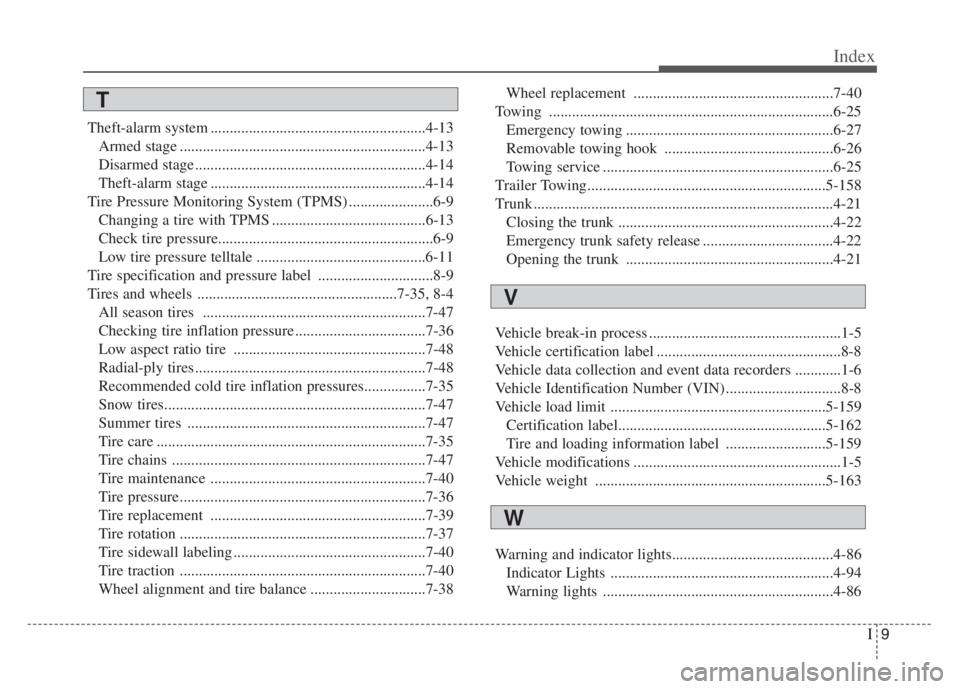TPMS KIA CADENZA 2020 User Guide
[x] Cancel search | Manufacturer: KIA, Model Year: 2020, Model line: CADENZA, Model: KIA CADENZA 2020Pages: 560, PDF Size: 11.37 MB
Page 429 of 560

613
What to do in an emergency
Changing a tire with TPMS
If you have a flat tire, the Low Tire
Pressure telltale will come on. Have
the flat tire repaired by an authorized
Kia dealer as soon as possible or
replace the flat tire with the spare
tire.
Each wheel is equipped with a tire
pressure sensor mounted inside the
tire behind the valve stem. You must
use TPMS specific wheels. It is rec-
ommended that you always have
your tires serviced by an authorized
Kia dealer.Even if you replace the low pressure
tire with the spare tire, the Low Tire
Pressure telltale will remain on until
the low pressure tire is repaired and
placed on the vehicle.
After you replace the low pressure
tire with the spare tire, the TPMS
malfunction indicator may illuminate
after a few minutes because the
TPMS sensor mounted on the spare
wheel is not initiated.
Once the low pressure tire is inflated
again to the recommended pressure
and installed on the vehicle or the
TPMS sensor mounted on the
replaced spare wheel is initiated by
an authorized Kia dealer, the TPMS
malfunction indicator and the low tire
pressure telltale will turn off within a
few minutes of driving.
If the indicator has not disappeared
after a few minutes of driving, please
visit an authorized Kia dealer.If an original mounted tire is replaced
with the spare tire, the TPMS sensor
on the replaced spare wheel should
be initiated and the TPMS sensor on
the original mounted wheel should be
deactivated. If the TPMS sensor on
the original mounted wheel located in
the spare tire carrier still activates,
the tire pressure monitoring system
may not operate properly. Have the
tire with TPMS serviced or replaced
by an authorized Kia dealer.
CAUTION- Repair Agents
Never use a puncture-repairing
agent not approved by Kia to
repair and/or inflate a low pres-
sure tire. The sealant not
approved by Kia may damage
the tire pressure sensor.
Page 430 of 560

What to do in an emergency
14 6
You may not be able to identify a low
tire by simply looking at it. Always
use a good quality tire pressure
gauge to measure the tire's inflation
pressure. Please note that a tire that
is hot (from being driven) will have a
higher pressure measurement than a
tire that is cold (from sitting station-
ary for at least 3 hours and driven
less than 1 mile (1.6 km) during that
3 hour period).
Allow the tire to cool before measur-
ing the inflation pressure. Always be
sure the tire is cold before inflating to
the recommended pressure.
A cold tire means the vehicle has
been sitting for 3 hours and driven for
less than 1 mile (1.6 km) in that 3
hour period.
Never use tire sealant if your vehicle
is equipped with a Tire Pressure
Monitoring System. The liquid
sealant not approved by Kia may
damage damage the tire pressure
sensors.
WARNING -TPMS
The TPMS cannot alert you to
severe and sudden tire dam-
age caused by external fac-
tors such as nails or road
debris.
If you feel any vehicle instabil-
ity, immediately take your foot
off the accelerator, apply the
brakes gradually and with
light force, and slowly move to
a safe position off the road.WARNING- Protecting
TPMS
Tampering with, modifying, or
disabling the Tire Pressure
Monitoring System (TPMS)
components may interfere with
the system's ability to warn the
driver of low tire pressure con-
ditions and/or TPMS malfunc-
tions. Tampering with, modify-
ing, or disabling the Tire
Pressure Monitoring System
(TPMS) components may void
the warranty for that portion of
the vehicle.
Page 558 of 560

I9
Index
Theft-alarm system ........................................................4-13
Armed stage ................................................................4-13
Disarmed stage ............................................................4-14
Theft-alarm stage ........................................................4-14
Tire Pressure Monitoring System (TPMS) ......................6-9
Changing a tire with TPMS ........................................6-13
Check tire pressure........................................................6-9
Low tire pressure telltale ............................................6-11
Tire specification and pressure label ..............................8-9
Tires and wheels ....................................................7-35, 8-4
All season tires ..........................................................7-47
Checking tire inflation pressure ..................................7-36
Low aspect ratio tire ..................................................7-48
Radial-ply tires ............................................................7-48
Recommended cold tire inflation pressures................7-35
Snow tires....................................................................7-47
Summer tires ..............................................................7-47
Tire care ......................................................................7-35
Tire chains ..................................................................7-47
Tire maintenance ........................................................7-40
Tire pressure................................................................7-36
Tire replacement ........................................................7-39
Tire rotation ................................................................7-37
Tire sidewall labeling ..................................................7-40
Tire traction ................................................................7-40
Wheel alignment and tire balance ..............................7-38Wheel replacement ....................................................7-40
Towing ..........................................................................6-25
Emergency towing ......................................................6-27
Removable towing hook ............................................6-26
Towing service ............................................................6-25
Trailer Towing..............................................................5-158
Trunk ..............................................................................4-21
Closing the trunk ........................................................4-22
Emergency trunk safety release ..................................4-22
Opening the trunk ......................................................4-21
Vehicle break-in process ..................................................1-5
Vehicle certification label ................................................8-8
Vehicle data collection and event data recorders ............1-6
Vehicle Identification Number (VIN) ..............................8-8
Vehicle load limit ........................................................5-159
Certification label......................................................5-162
Tire and loading information label ..........................5-159
Vehicle modifications ......................................................1-5
Vehicle weight ............................................................5-163
Warning and indicator lights..........................................4-86
Indicator Lights ..........................................................4-94
Warning lights ............................................................4-86
T
V
W